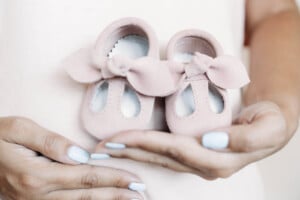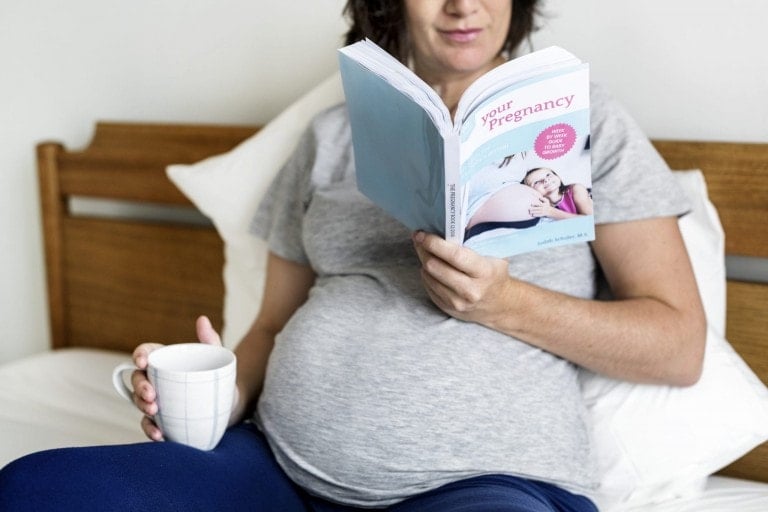You are at the final stretch—your third trimester! You are getting close to meeting your sweet baby, so now it’s crunch time. It’s surreal that today marks my 28th week—the third trimester. It feels like we are finally almost there. My bump sure looks like it, at least. 😉 If you’re curious about what the absolute essentials are to do before baby arrives, look no further. I’m taking the guesswork out of your third trimester of pregnancy and sharing the top 13 items on my third trimester checklist to complete.
1. Go to your childbirth class.
You should go to your childbirth class towards the end of your pregnancy, so all of the information that you learn stays fresh in your mind for the big day. If you are signed up for a 4-week, 6-week, or 12-week course, be sure to finish these classes by your 36th or 37th week.
2. Have fun at your baby shower!
Once baby arrives, everything is all about baby, so soak up this much-deserved love and attention and enjoy! Don’t forget to write your thank-you notes within a week after your shower. (Most showers are hosted during your 7th month of pregnancy.)
3. Attend a newborn care class, a breastfeeding class (if you plan on breastfeeding), and an infant CPR class.
During the third trimester, brush up on your parenting skills, such as how to change a diaper, give baby a bath, how to swaddle, and more. Breastfeeding is also a learned skill, so attending a breastfeeding class can get you started on the right foot. And I believe it’s a good idea for parents and grandparents or anyone caring for your baby to learn infant CPR and child CPR. We hope you never have to use it, but you will be grateful if you ever do.
4. Pack your hospital bags and have them ready with your birth plan.
Baby can arrive early, so it’s important to know what to pack in your hospital bag and have them ready to go! If you are high-risk, you may even want to have them in the car with you when you go to your final prenatal appointments. This is just in case there is an emergency and your doctor wants you to be admitted to labor and delivery immediately after an appointment.
Also, have your birth plan completed and make a plan for your older children when you go into labor and are away at the hospital.
5. Download a contraction timer and baby feeding/sleeping tracking app.
Rather than counting the minutes and doing the math in your head, have a contraction timer app already downloaded on your phone and your partner’s phone. This is a great thing your partner can help with before you get to the hospital. Also, once baby is here, it’s helpful to have a baby tracking app rather than writing everything down that your baby does. There are even apps that sync together so everyone who cares for your child (nanny or grandparents) can log and track everything that is going on with the baby.
6. Install baby’s car seat.
The hospital or birth center will not let you leave without your infant car seat correctly installed. And while you’re at it, double-check that your baby monitors, stroller, and other baby essentials are ready and working perfectly.
Check out these helpful related articles:
7. Cook and freeze meals for after your delivery.
The last thing you will want to do after having a baby is worry about what you will be making for dinner. And if you’re breastfeeding, have some healthy meals and snacks in the house to help with your milk supply. Stock your fridge, freezer, and pantry to have some healthy meals that will be easy for you and your partner to heat up and prepare quickly.
8. Start eating six dates daily.
This may sound strange, but eating dates during pregnancy helps with uterine tone. It’s been shown that women who ate around six dates a day have had shorter labors!1 Yes, please!
9. Wash, fold, and put away all of your baby clothes.
10. Buy any baby items still needed.
There may be some big-ticket items that you still need—maybe a baby carrier, stroller, or car seat. This is the time to check what you don’t have and get the must-haves. Also, make sure you are stocked up on diapers and wipes!
11. Choose your pediatrician.
You interviewed all of these great doctors, but now you must choose a pediatrician and notify them that you have chosen them. Remember the name of your pediatrician because the hospital will ask you who your child’s pediatrician is once you are admitted.
12. Create a postpartum plan and organize your support system after having a baby.
Will you have family come to help you in the first few weeks? Do you want overnight help from a postpartum doula so you can get some rest and sleep? Will friends be bringing you food? It’s essential to build a support system around you. If you are planning to breastfeed, locate a lactation consultant in your area. Join a mom’s support group to make new friends. Writing out your wishes for those first few weeks and months with baby is so helpful. Check out this postpartum plan template for inspiration.
Share this article with your friends and family: The BEST Things to Do for a New Mom
13. Soak in the last few moments of pregnancy.
You are probably over being pregnant and ready to meet your baby, but there will be moments when you will miss the feeling of baby moving around inside you. Cherish these last days with your bump and do something nice for yourself, like getting a massage, a wax—if that’s your thing—or a mani-pedi. The end is almost here. Or should I say the beginning? 😉
Read Next: Third Trimester Must-Haves































